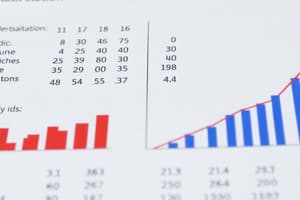Podcast
Questions and Answers
What is the primary purpose of inferential statistics?
What is the primary purpose of inferential statistics?
- To present data visually
- To estimate characteristics of a large population from a sample (correct)
- To summarize and describe datasets
- To collect data from qualitative sources
Which of the following is a characteristic of quantitative data?
Which of the following is a characteristic of quantitative data?
- It describes attributes of a population
- It is based solely on measurements
- It includes categories like ethnicity
- It is always numerical (correct)
Which term describes a numerical characteristic of the entire population?
Which term describes a numerical characteristic of the entire population?
- Parameter (correct)
- Sample
- Variable
- Statistic
What does the term 'mean' commonly refer to in statistics?
What does the term 'mean' commonly refer to in statistics?
What is a datum?
What is a datum?
Which of the following is an example of qualitative data?
Which of the following is an example of qualitative data?
In statistics, the term 'variable' refers to what?
In statistics, the term 'variable' refers to what?
Which of the following is NOT a method of descriptive statistics?
Which of the following is NOT a method of descriptive statistics?
What defines quantitative discrete data?
What defines quantitative discrete data?
Which of the following best represents quantitative continuous data?
Which of the following best represents quantitative continuous data?
Which type of sampling gives every member of a population an equal chance of being selected?
Which type of sampling gives every member of a population an equal chance of being selected?
What is a key characteristic of systematic sampling?
What is a key characteristic of systematic sampling?
What distinguishes a sample from a population in research?
What distinguishes a sample from a population in research?
Which statement accurately describes probability sampling methods?
Which statement accurately describes probability sampling methods?
In the context of sampling, what does stratified sampling involve?
In the context of sampling, what does stratified sampling involve?
How are the weights of backpacks with books classified?
How are the weights of backpacks with books classified?
Flashcards are hidden until you start studying
Study Notes
Definitions of Key Terms
- Statistics: Science concerned with collecting, analyzing, interpreting, and presenting data.
- Descriptive Statistics: Methods to summarize and describe key features of a dataset, such as mean, median, and mode.
- Inferential Statistics: Uses a sample to estimate characteristics of a population and test research hypotheses.
- Probability: Mathematical study of randomness, focusing on the likelihood of events occurring.
Data and Sampling Concepts
- Population: Entire group of individuals or objects under study.
- Sample: Specific group selected from the population for data collection.
- Statistic: Numerical property derived from a sample.
- Parameter: Numerical characteristic of a population estimated through a statistic.
- Variable: A measurable attribute of population members, can be numerical or categorical.
- Data: Actual values of variables; Datum is a single value.
Types of Data
- Qualitative Data: Categorizes or describes attributes of a population (e.g., height, blood type).
- Quantitative Data: Always numerical, resulting from counting or measuring (e.g., weights, lengths).
- Quantitative Discrete Data: Countable data (e.g., number of books).
- Quantitative Continuous Data: Results from measurements (e.g., weights of backpacks).
Data Examples
- Weight of backpacks (quantitative continuous data): Sample weights include 6.2, 7, 6.8, 9.1, 4.3 pounds.
- Number of books (quantitative discrete data): Sample includes counts of one to four books carried by students.
Population vs Sample
- Population Characteristics: Defined by geographical, age, income, or other attributes.
- Sample Characteristics: Specific group from which data is collected, providing insights about the population.
Probability Sampling Methods
- Ensures every population member has a chance of selection, crucial for quantitative research.
- Types of Probability Sampling:
- Simple Random Sampling: Equal chance for all population members; can use random number generators.
- Systematic Sampling: Members are chosen at regular intervals from an ordered list.
- Stratified Sampling: Population divided into strata; samples taken from each stratum.
Studying That Suits You
Use AI to generate personalized quizzes and flashcards to suit your learning preferences.




